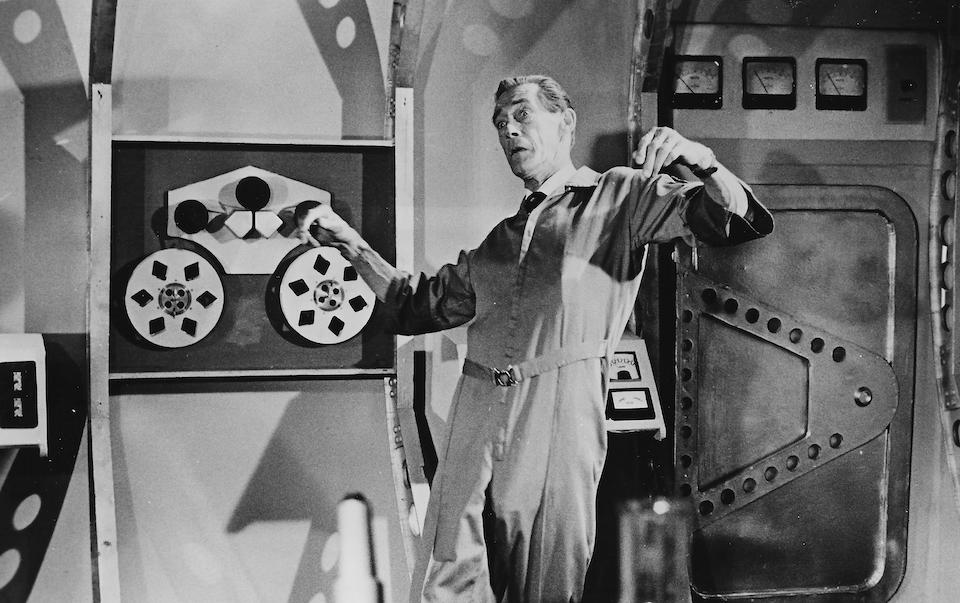
Horror of the Blood Monsters (USA, 1970) 85 min color DIR-PROD: Al Adamson. SCR: Sue McNair. MUSIC: Mike Velarde. DOP: William G. Troiano, Vilmos Zsigmond, Gary Graver. EDITOR: Peter Perry Jr. SPECIAL EFFECTS: David L. Hewitt. CAST: John Carradine, Robert Dix, Vicki Volante, Joey Benson, Jennifer Bishop, Bruce Powers, Fred Meyers, Britt Semand, John ‘Bud’ Cardos, Brother Theodore. (Independent-International)
A little context. This review is excerpted from a two-part article I had written way back in 2004 about the horror films of director Al Adamson, for the much-missed e-zine, Horror-Wood, edited by the late Joe Meadows, and presented here as tribute to the legendary producer Sam Sherman, Adamson’s frequent collaborator, who passed away on September 29.
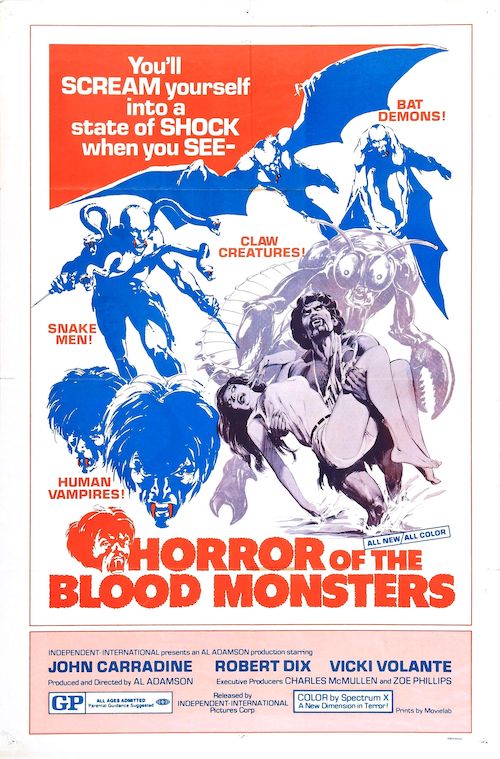
Horror of the Blood Monsters is one of the many chop jobs that Al Adamson and Sam Sherman would make under the latter’s Independent-International banner, in which they combined footage from different projects and then attempted to make narrative sense of it all (the most notorious of these is Dracula Vs. Frankenstein). The foundation of this one is a Filipino vampire-caveman movie called Tagani, which Sherman purchased and then added new scenes of American actors (John Carradine, Robert Dix, Vicki Volante et al) as spaceman landing on an alien world reacting to all the caveman action offscreen.
Both exploitation and experimental filmmakers alike have appropriated previously shot footage and shaped it into something else. One could argue the merits of either camp. Either way, the different source materials call attention to themselves, reminding us of the artifice that cinema really is. However, the work of Al Adamson and Sam Sherman appears avant garde because the narrative is drained by adding plots, not subtracting them. Of all of the times in which Adamson attempted a coherent narrative out of different sources, this one actually works! Sort of. And yet, Horror of the Blood Monsters is one of Adamson’s most entertaining and (dare I say it?) charming films, even if it ends up as a shaggy dog joke.
Before we continue, I think it is imperative to mention that one appeal of the I-I flicks was their wild opening credit sequences. The cartoony graphics, Warhol-ish portraitures and bold colours of these great teasers would actually be the segments which most fulfilled the lurid promise of the films’ tantalizing titles.
This picture was made just before Vilmos Zsigmond hit the big time, but one assumes the opening sequences were shot later by one of the two other cinematographers (William G. Troiano, and an uncredited Gary Graver). The Spartan opening scenes of the vampires prowling around alleys have a minimalist beauty in their own right. Vampires prowling around, you ask? Ah yes. One is put in a daze right from the start of this crazy picture, as an uncredited Brother Theodore rambles on about how vampires originated from another planet, and to stop this menace, he acquiesces that we have to journey to outer space.
Well, considering that there are a whopping six vampires running around an alley, I’m not sure how much of a global threat this is. However, you do get to see a cameo by Al himself as one of the vampires. Despite these hilarious fangs, he actually resembles Henry Hull in Werewolf of London. These opening moments are rather effective, if you don’t think about them too hard.
We are next introduced to the crew of the spaceship XP 13, presumably heeding Brother Theodore’s advice. The gruff Dr. Rynning, played by the immortal John Carradine, captains the mission. These opening scenes are like the rest of the picture, shamelessly drawn out to ensure that it clocks in at a respectable running time. On the ground, Dr. Manning (Robert Dix) and Valerie (Vicki Volante) sit at a control panel, saying “prepare for liftoff”, “Roger” and other inconsequential dialogue over and over. The ship experiences some turbulence after lift-off, shipmates Bob and Linda blather on and on about the safety of the mission, and Carradine goes around spouting technical jargon.
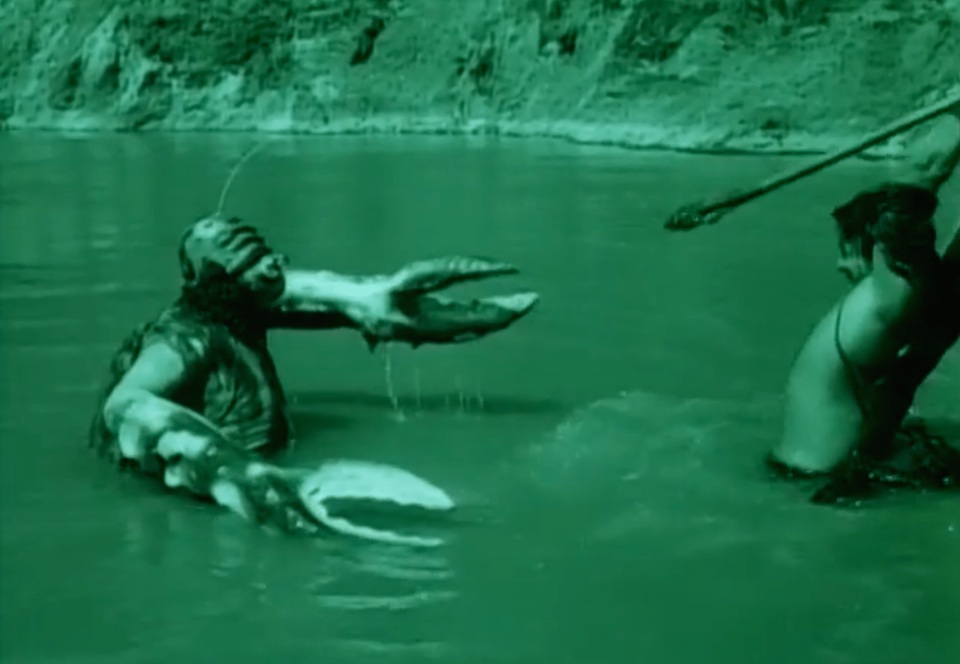
The film is perhaps most interesting for its depiction of life in a futuristic setting (one assumes it is the future, based on the ability to travel to other worlds). There is not one, but two sex scenes, between Manning and Valerie: lovemaking in the future consists of electrodes taped to one’s temples, and enjoying carnal activity hooked up to a control panel with a lot of groovy flashing lights. (Probably not as fun as the Orgasmatron in Sleeper.)
This notion predates Adamson’s later “futuristic sex musical” Cinderella 2000, which also offers a dystopian, antiseptic environment. Even though we get to see the fetching Vicki Volante in between the sheets (twice!) these moments are devoid of passion. Humankind is already as bloodless as the vampires. Adamson’s films are typically void of romance, and even this “classically shot” picture is no exception.
Horror of the Blood Monsters feels like a low-budget mid-60s spaceship movie a la Planet of Blood, not least because wunderkind David L. Hewitt contributed some cheap special effects and miniatures, including some from the director’s own rock-bottom space opera, Wizard of Mars (which also starred Carradine- it figures). The ship’s landing is an obvious model resting atop a rock! Moments of the rocket in flight feature a silly paper flame coming out of the exhaust. These dime-store special effects wouldn’t even have fooled the most undemanding viewer of Rocky Jones, Space Ranger. It takes a special kind of crass filmmaker to throw in such blatantly phoney moments, and brother, you haven’t seen anything yet!
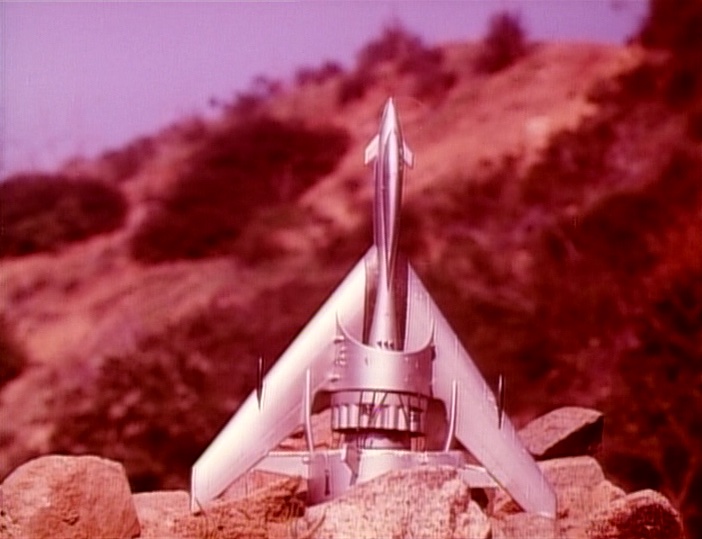
Once the astronauts go on the planet surface, they react to all the offscreen footage of Tagani, which is presented in tints of red, green or sepia, because the caveman movie was shot in black and white. The gels are explained away by stating that the planet is infected by radiation. This babble is given credence because the good Tagani tribe endlessly battles with the Tubata tribe, who all wear these silly vampire fangs, thus supporting Carradine’s theory of the mutations on the planet. (Mind you, the bat-people who fly around in the caverns are pretty cool.) And if that’s not enough, modern-day actors react to cut-ins of stuff a generation or two older: dinosaurs from Willis O’Brien’s 1925 The Lost World, and lizards fighting from One Million B.C. by way of Robot Monster! Now that’s plunder!
The Tagani footage has some additional weight with the inclusion of the beautiful Jennifer Bishop as the cave girl Lian, who meets up with the landing party. Willy is so smitten with her that he gives her a necklace. While the crew members find some crude elements by which to re-power the ship so they can take off, offscreen cave people besiege the landing party. A Tubata tribesperson stabs Bob, and then Steve plugs the evil doer before he collapses from the radiation. Oh yes— to make the film longer, Manning and Valerie also discuss the planet’s radiation, which was already explained to us. When the crew is ready to depart, Willy grudgingly leaves Lian, clasping her necklace, looking longingly offscreen at the model spaceship on the bloody rock.
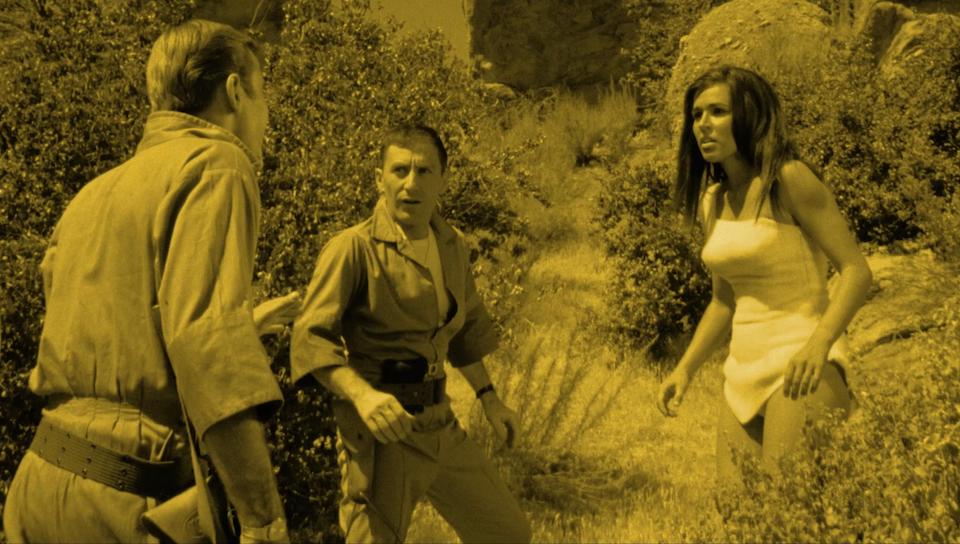
With some more moments in space, including a paper flame fluttering out the back, Carradine attempts to explain away the ending, stating that the radiation will not affect the crew as there is something in the Earth’s atmosphere that negates it. As this dizzying picture draws to a close, Dr. Rynning muses that this planet once had a brilliant race of people before the radiation. “I have no doubt we will be as brilliant one day.” The end.
What a minute! What about the bloody vampires? I guess after such a crazy movie experience, the filmmakers hoped that opening would have been nicely forgotten. Then we realize we’ve just sat through a shaggy dog joke of a movie that added up to completely nothing, but it was damn fun along the way. The French Dadaists would have loved it.